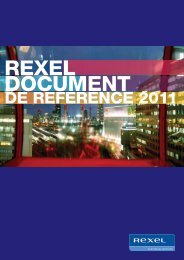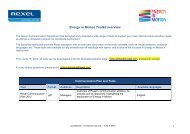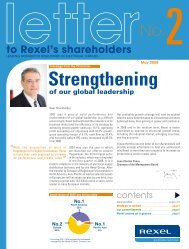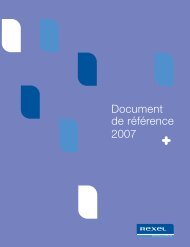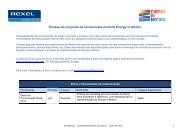2008 Registration Document - Rexel
2008 Registration Document - Rexel
2008 Registration Document - Rexel
Create successful ePaper yourself
Turn your PDF publications into a flip-book with our unique Google optimized e-Paper software.
an expense in profit and loss and will have no legal orconstructive obligation to pay further contributions, or− defined benefit plans when the employer guarantees afuture level of benefits.The Group’s net obligation in respect of defined postemploymentbenefit plans, including pension plans, iscalculated separately for each plan by estimating theamount of future benefit that employees have earned inreturn for their service in the current and prior periods. Thatbenefit is discounted to determine its present value, andthe fair value of any plan assets is deducted. The discountrate is the yield at the balance sheet date on high qualitycorporate bonds that have maturity dates approximatingthe terms of the Group’s obligations. The calculation isperformed periodically by an independent actuary usingthe projected unit credit method.The liability recognized in the balance sheet in respect ofdefined benefit schemes is the present value of the definedbenefit obligation at the balance sheet date less the fair valueof plan assets, together with adjustments for unrecognizedactuarial gains and losses and past service costs.When the benefits of a plan are improved (reduced), theportion of the increased (decreased) benefit relating to pastservice by employees is recognized as an expense (income)in the income statement on a straight-line basis over theaverage period until the benefits become vested. To theextent that the benefits vest immediately, the expense(income) is recognized immediately in profit or loss.The Group recognizes actuarial gains and losses (resultingfrom changes in actuarial assumptions) using the corridormethod. Under the corridor method, to the extent thatany cumulative unrecognized actuarial gain or lossexceeds 10 percent of the greater of the present valueof the defined benefit obligation and the fair value of planassets, that portion is recognized in profit or loss over theexpected average remaining working lives of the employeesparticipating in the plan. Otherwise, the actuarial gain orloss is not recognized.When the calculation results in plan assets exceedingGroup’s liabilities, the recognized asset is limited to the nettotal of any unrecognized actuarial losses and past servicecosts and the present value of any currently available futurerefunds from the plan or reductions in future contributionsto the plan when refunds arise from unconditional rights.The current and past service costs are presented in theincome statement as part of the personnel expense.The interest expenses (income) relating to the unwindingof the discounting of the defined benefit obligation and theexpected return on plan assets are presented in financialincome and expenses.Other long-term benefitsLong-term benefits mainly include jubilees or long serviceleaves. The Group’s net obligation in respect of long-termbenefits, other than post-employment plans, is the amountof future benefit that employees have earned in return fortheir service in the current and prior periods. The obligationis calculated using the projected unit credit method andis discounted at a rate equal to the yield at the balancesheet date on high quality corporate bonds that havematurity dates approximating to the terms of the Group’sobligations.Actuarial gains and losses are immediately recognized inthe income statement.2.14 Share-based payment transactionsFree shares and stock option programmes allow theGroup employees to acquire shares of the Group entities.The fair value of options granted is recognized as apersonnel expense with a corresponding increase in otherreserves in equity (when the plan qualifies as equitysettled)over the period during which the employeesbecome unconditionally entitled to the options (the vestingperiod). The expense is based on Group’s estimates of theacquired equity instruments in accordance with conditionsof granting.The fair value is measured at grant date using a Black &Scholes model or a binomial model in accordance with thecharacteristics of the plans.The proceeds received net of any directly attributable costsare recognized as an increase in share capital (for thenominal value) and share premium when equity instrumentsare exercised.2.15 ProvisionsA provision is recognized in the balance sheet when theGroup has a present legal or constructive obligation as aresult of a past event, when it is probable that an outflow ofeconomic benefits will be required to settle the obligationand when the amount can be estimated reliably.If the effect of time value is material, provisions aredetermined by discounting the expected future cash flowsat a rate that reflects current market assessments of thetime value of money and, when appropriate, the risksspecific to the liability.RestructuringA restructuring is a programme that is planned andcontrolled by management that materially changes eitherthe scope of the business or the manner in which thatbusiness is conducted.A provision for restructuring is recognized when theGroup has approved a detailed and formal restructuringplan, and the restructuring either has commenced orhas been announced publicly. Future operating lossesare not provided for. Certain restructuring expensesare presented in “Other expenses”. Restructuring costsprincipally include personnel costs (severance payments,early retirement costs, notice time not worked), branchclosure costs, and indemnities for the breach of noncancellableagreements.REXEL <strong>2008</strong> | PAGE 167





